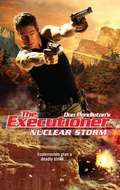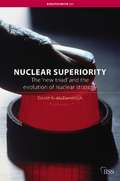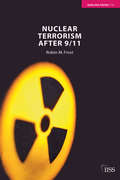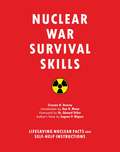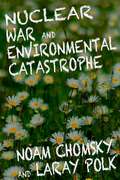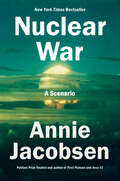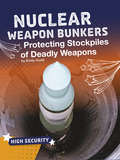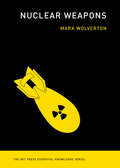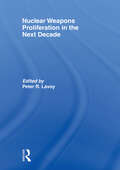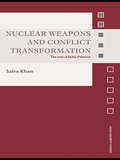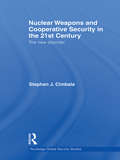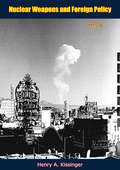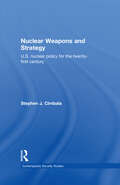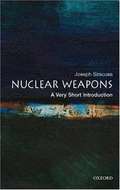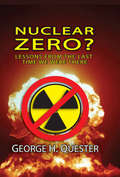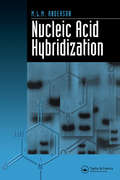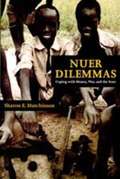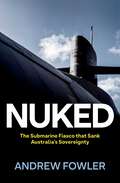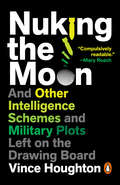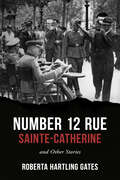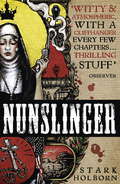- Table View
- List View
Nuclear Storm
by Don PendletonAn ecoterrorist group has set up base in a secluded part of Yellowstone National Park with a plan to save the planet. Believing mankind is a virus that must be eradicated, the group has set in motion a plot to kill millions in seconds and leave the rest of the human race on the verge of extinction. Nothing will throw them off course-including any campers who try to stop them. But Mack Bolan isn't your average outdoorsman. Unarmed, with only his wits and nature on his side as the clock ticks down to a nuclear disaster, Bolan knows the best chance for saving countless innocent lives and averting a global crisis is through guerrilla warfare. The terrorists may be on a mission to destroy man, but the Executioner has his own elimination objectives.
Nuclear Superiority: The 'New Triad' and the Evolution of American Nuclear Strategy (Adelphi series)
by David S. McDonoughIn 2002 the Bush administration completed a Nuclear Posture Review that introduced a ‘new triad’ based on offensive-strike systems, defences and a revitalized defence infrastructure. The new triad is designed for a new strategic threat environment, characterized not by a long-standing nuclear rivalry with another superpower, but by unstable relationships with rogue-state proliferators, alongside more ambiguous relations with nuclear-weapon powers. Providing a historical context to these modifications to US nuclear strategy, Nuclear Superiority details how the new triad, which strongly emphasizes the need to bolster the credibility of the nuclear deterrent and to prepare for nuclear use when deterrence fails, is founded on previous efforts to secure nuclear superiority against the Soviet Union and counter-proliferation capabilities against WMD-proliferant adversaries. It illustrates how the evolution of American nuclear strategy towards more effective counter-force capabilities, regardless of the current threat environment, has led to a host of counter-force developments. David S. McDonough explores how this strategy is based on the long-standing American desire to control conflict escalation and how it may invite crisis instability with regional adversaries and disquiet among established nuclear powers.
Nuclear Terrorism after 9/11 (Adelphi series #378)
by Robin M. FrostThe very mention of nuclear terrorism is enough to rouse strong reactions, and understandably so, because it combines the most terrifying weapons and the most threatening of people in a single phrase. The possibility that terrorists could obtain and use nuclear weapons deserves careful analysis, but discussion has all too often been contaminated with exaggeration, even hysteria. For example, it has been claimed that nuclear terrorism poses an ‘existential threat’ to the United States. This Adelphi Paper develops a more measured analysis of the risk of terrorists detonating a true fission device. The problem is attacked from two perspectives: the considerable, possibly insurmountable, technical challenges involved in obtaining a functional nuclear weapon, whether ‘home-made’ or begged, borrowed or stolen from a state arsenal; and the question of the strategic, political and psychological motivations to ‘go nuclear’. The conclusions are that nuclear terrorism is a less significant threat than is commonly believed, and that, among terrorists, Muslim extremists are not the most likely to use nuclear weapons.
Nuclear Threats, Nuclear Fear, and the Cold War of the 1980s (Publications of the German Historical Institute)
by Jeremy Varon Martin Klimke Eckart ConzeThis book brings together cutting-edge scholarship from the United States and Europe to address political as well as cultural responses to both the arms race of the 1980s and the ascent of nuclear energy as a second, controversial dimension of the nuclear age. Diverse in its topics and disciplinary approaches, Nuclear Threats, Nuclear Fear and the Cold War of the 1980s makes a fundamental contribution to the emerging historiography of the 1980s as a whole. As of now, the era's nuclear tensions have been addressed by scholars mostly from the standpoint of security studies, focused on the geo-strategic deliberations of political elites and at the level of state policy. Yet nuclear anxieties, as the essays in this volume document, were so pervasive that they profoundly shaped the era's culture, its habits of mind, and its politics, far beyond the domain of policy. Brings together scholarship from the United States and Europe to examine the dynamics of anti-nuclear protest movements in the West in the 1980s. Contributes to the emerging historiography of the 1980s by focusing on an under-researched aspect of the decade. Attests to the vital role of culture in communicating and popularizing anti-nuclear messages, with bearing on transformations in culture in the 1980s as a whole.
Nuclear War Survival Skills: Lifesaving Nuclear Facts and Self-Help Instructions
by Cresson H. KearnyA field-tested guide to surviving a nuclear attack, written by a revered civil defense expert. This edition of Cresson H. Kearny’s iconic Nuclear War Survival Skills (originally published in 1979), updated by Kearny himself in 1987 and again in 2001, offers expert advice for ensuring your family’s safety should the worst come to pass. Chock-full of practical instructions and preventative measures, Nuclear War Survival Skills is based on years of meticulous scientific research conducted by Oak Ridge National Laboratory. Featuring a new introduction by ex-Navy SEAL Don Mann, this book also includes: instructions for six different fallout shelters, myths and facts about the dangers of nuclear weapons, tips for maintaining an adequate food and water supply, a foreword by “the father of the hydrogen bomb,” physicist Dr. Edward Teller, and an “About the Author” note by Eugene P. Wigner, physicist and Nobel Laureate. Written at a time when global tensions were at their peak, Nuclear War Survival Skills remains relevant in the dangerous age in which we now live.
Nuclear War and Environmental Catastrophe
by Noam Chomksy Laray Polk"There are two problems for our species' survival--nuclear war and environmental catastrophe, " says Noam Chomsky in this new book on the two existential threats of our time and their points of intersection since World War II.While a nuclear strike would require action, environmental catastrophe is partially defined by willful inaction in response to human-induced climate change. Denial of the facts is only half the equation. Other contributing factors include extreme techniques for the extraction of remaining carbon deposits, the elimination of agricultural land for bio-fuel, the construction of dams, and the destruction of forests that are crucial for carbon sequestration.On the subject of current nuclear tensions, Chomsky revisits the long-established option of a nuclear-weapon-free zone (NWFZ) in the Middle East, a proposal set in motion through a joint Egyptian Iranian General Assembly resolution in 1974.Intended as a warning, Nuclear War and Environmental Catastrophe is also a reminder that talking about the unspeakable can still be done with humor, with wit and indomitable spirit.
Nuclear War: A Scenario
by Annie JacobsenThe INSTANT New York Times bestseller Instant Los Angeles Times bestsellerOne of NPR's Books We LoveOne of Newsweek Staffers' Favorite Books of the YearShortlisted for the Baillie Gifford Prize&“In Nuclear War: A Scenario, Annie Jacobsen gives us a vivid picture of what could happen if our nuclear guardians fail…Terrifying.&”—Wall Street Journal There is only one scenario other than an asteroid strike that could end the world as we know it in a matter of hours: nuclear war. And one of the triggers for that war would be a nuclear missile inbound toward the United States. Every generation, a journalist has looked deep into the heart of the nuclear military establishment: the technologies, the safeguards, the plans, and the risks. These investigations are vital to how we understand the world we really live in—where one nuclear missile will beget one in return, and where the choreography of the world&’s end requires massive decisions made on seconds&’ notice with information that is only as good as the intelligence we have. Pulitzer Prize finalist Annie Jacobsen&’s Nuclear War: A Scenario explores this ticking-clock scenario, based on dozens of exclusive new interviews with military and civilian experts who have built the weapons, have been privy to the response plans, and have been responsible for those decisions should they have needed to be made. Nuclear War: A Scenario examines the handful of minutes after a nuclear missile launch. It is essential reading, and unlike any other book in its depth and urgency.
Nuclear Weapon Bunkers: Protecting Stockpiles of Deadly Weapons (High Security)
by Emily HuddNuclear weapon bunkers keep the world's dangerous nuclear weapons safe. Guards, electronic security systems, and barriers protect the bunkers. Learn more about these high-security places!
Nuclear Weapons (The MIT Press Essential Knowledge series)
by Mark WolvertonA primer on nuclear weapons, from the science of fission and fusion to the pursuit of mutual assured destruction, the SALT treaties, and the Bomb in pop culture.Although the world&’s attention has shifted to drone-controlled bombing and cyberwarfare, the threat of nuclear war still exists. There are now fourteen thousand nuclear weapons in the hands of the nine declared nuclear powers. Even though the world survived the Cold War, we need to understand what it means to live with nuclear weapons. In this volume in the MIT Press Essential Knowledge series, Mark Wolverton offers a primer on nuclear weapons, from the science of fission and fusion to the pursuit of mutual assured destruction, the SALT and START agreements, and the Bomb in pop culture. Wolverton explains the basic scientific facts, offers historical perspective, and provides a nuanced view of the unique political, social, and moral dilemmas posed by nuclear weapons. He describes the birth of the Bomb in 1945 and its use against the Japanese cities of Hiroshima and Nagasaki; explains how a nuclear bomb works; recounts episodes when the world came close to waging nuclear war, including the Cuban missile crisis in 1962; discusses nuclear policy and nuclear treaties; and traces the influence of such films as On the Beach, Dr. Strangelove, and The Day After.
Nuclear Weapons Proliferation in the Next Decade
by Peter R. LavoyThe intensification of the Iranian and North Korean nuclear crises has created new fears that deteriorating security conditions in the Middle East, Northeast Asia, and other regions will lead additional countries to seek their own nuclear arsenals in the years to come. This special issue examines the factors that are likely to shape nuclear weapons proliferation over the next decade. The internationally recognized authors of this issue, many of whom are prominent scholars and others of whom have held influential governmental positions with responsibility for countering nuclear proliferation, bring to light the conditions and events that might drive new countries to pursue nuclear weapons; the indicators and cautionary signs that can provide early warning that a country is interested in building nuclear bombs; and the policy and military measures that can be adopted to prevent or at least dissuade new proliferators. The introductory chapter develops a novel analytical approach focusing on the role of nuclear myths and mythmakers and the subsequent chapters draw on this approach to help analysts better understand and policy makers better manage nuclear proliferation over the next ten years.
Nuclear Weapons and Conflict Transformation: The Case of India-Pakistan (Asian Security Studies)
by Saira KhanThis new volume explores what the acquisition of nuclear weapons means for the life of a protracted conflict.The book argues that the significance of the possession of nuclear weapons in conflict resolution has been previously overlooked. Saira Khan argues that the acquisition of nuclear weapons by states keeps conflicts alive indefinitely, as
Nuclear Weapons and Cooperative Security in the 21st Century: The New Disorder (Routledge Global Security Studies)
by Stephen J. CimbalaThis book looks at the prospects for international cooperation over nuclear weapons proliferation in the 21st century. Nuclear weapons served as stabilizing forces during the Cold War, or the First Nuclear Age, on account of their capability for destruction, the fear that this created among politicians and publics, and the domination of the nuclear world order by two superpowers: the United States and the Soviet Union. The end of the Cold War, the dissolution of the Soviet Union, and the potential for nuclear weapons acquisition among revisionist states, or even non-state actors including terrorists, creates the possibility of a 'wolves eat dogs' phenomenon in the present century. In the 21st century, three forces threaten to undo or weaken the long nuclear peace and fast-forward states into a new and more dangerous situation: the existence of large US and Russian nuclear weapons arsenals; the potential for new technologies, including missile defenses and long-range, precision conventional weapons, and a collapse or atrophy of the nuclear nonproliferation regime, and the opening of the door for nuclear weapons to spread among more than the currently acknowledged nuclear states. This book explains how these three 'weakening' forces interact with one another and with US and Russian policy-making in order to create an environment of large possibilities for cooperative security - but also of considerable danger. Instead, the choices made by military planners and policy-makers will create an early twenty-first century story privileging nuclear stability or chaos. The US and Russia can, and should, make incremental progress in arms control and nonproliferation. This book will be of much interest to students of nuclear proliferation and arms control, strategic studies, international security and IR in general. Stephen J. Cimbala is Distinguished Professor of Political Science at Pennsylvania State University. He is the author of numerous works in the fields of international security, defense studies, nuclear arms control and other topics. He has consulted for various US government agencies and defense contractors.
Nuclear Weapons and Foreign Policy 1957 ed.
by Henry A. KissingerNow that there exist weapons capable of destroying humanity, our nation’s survival depends on our ability to find answers to two questions: What challenges should be resisted by force? How can they be resisted without brining disaster to our society?We must find a strategy which can support our diplomacy without being forced to risk our national substance on every issue. Otherwise we will increasingly face the grim alternative of total annihilation or total surrender.This book shows how our military strength can support our political objectives without excessive risk of all-out war. It discusses the diplomacy and the strategy necessary to deter aggression and to defeat it should it come. It makes clear that we require weapons as varied as the dangers confronting us. War can be avoided only by being ready for it.Nuclear Weapons and Foreign Policy, though entirely Dr. Kissinger’s own book, grew out of his work over a period of eighteen months with a group of experts organized by the Council on Foreign Relations and led by Mr. Gordon Dean, former Chairman of the Atomic Energy Commission. It deals primarily with the revolution produced by the development of nuclear weapons, and the effect which this revolution should have on our military strategy and foreign policy.Dr. Kissinger indicates that in all significant wars of the future, nuclear weapons are likely to be employed, but he shows that if proper doctrine is followed, the consequences need not be disastrous to our survival, as is often supposed.He then examines the implications of his new strategy for our relations with our allies and with the uncommitted countries of the world. And he analyzes the nature of the Soviet challenge in terms of ideology, diplomacy, and military policy.This book is of vital importance and certain to inspire serious thought.
Nuclear Weapons and Strategy: US Nuclear Policy for the Twenty-First Century (Contemporary Security Studies)
by Stephen J. CimbalaNuclear weapons, once thought to have been marginalized by the end of the Cold War, have returned with a vengeance to the centre of US security concerns and to a world bereft of the old certainties of deterrence. This is a major analysis of these new strategic realities. The George W. Bush administration, having deposed the regime of Saddam Hussein in Iraq, now points to a new nuclear "Axis of Evil": Iran and North Korea. These nations and other rogue states, as well as terrorists, may pose key threats because they are "beyond deterrence", which was based on the credible fear of retaliation after attack. This new study places these and other developments, such as the clear potential for a new nuclear arms race in Asia, within the context of evolving US security policy. Detailing the important milestones in the development of US nuclear strategy and considering the present and future security dilemmas related to nuclear weapons this is a major new contribution to our understanding of the present international climate and the future. Individual chapters are devoted to the key issues of missile defenses, nuclear proliferation and Israel’s nuclear deterrent. This book will be of great interest to all students and scholars of strategic studies, international relations and US foreign policy.
Nuclear Weapons: A Very Short Introduction
by Joseph M. SiracusaDespite not having been used in anger since Hiroshima and Nagasaki, nuclear weapons are still the biggest threat that faces us in the 21st century. Indeed, for all the effort to reduce nuclear stockpiles to zero and to keep other nations (such as Iran) from developing nuclear capability, it seems that the Bomb is here to stay. In this gripping Very Short Introduction, Joseph M. Siracusa, an internationally respected authority on nuclear arms, provides a comprehensive, accessible, and at times chilling overview of the most deadly weapon ever invented. Siracusa explains the history of the arms race and the politics of the bomb, ranging from the technology of nuclear weapons, to the revolutionary implications of the H-bomb and the politics of nuclear deterrence. The issues are set against a backdrop of the changing international landscape, from the early days of development, through the Cold War, to the present-day controversy over George W. Bush's National Missile Defense, and the role of nuclear weapons in an Age of Terror. Providing an accessible and eye-opening backdrop to one of the most unsettling aspects of the modern world, this compact introduction is must reading.
Nuclear Zero?: Lessons from the Last Time We Were There
by George H. Quester"George H. Quester argues that the possibility of nuclear war continues to loom despite the reduction in stockpiles by the major powers. Supporters of total nuclear disarmament often dismiss pessimistic objections to the possibility of reaching nuclear zero as being hypothetical, but this book looks at real illustrations for this possibility, taken from the years that gave the world the Manhattan Project.Any advocate of total nuclear disarmament must deal with the challenge of ""realist"" analysts of international relations, those who worry that being at zero nuclear weapons, or even close to zero, would be unstable and dangerous. Mutual fears could be self-confirming, leading to cheating on disarmament, and even nuclear war. While such fears are often dismissed as theoretical or hypothetical, this book attempts to test them against the real-life experience of the last time we were at nuclear zero. The years from 1933 to 1945 saw many such self-confirming fears, leading to the Manhattan Project and the nuclear destruction of Hiroshima and Nagasaki.Optimism about the future cannot be ruled out totally, but the history of our experience with nuclear disarmament must be examined carefully to identify the crucial prerequisites for elimination of such weapons of mass destruction. This book is required reading for courses on arms control, defense policy, and international relations, or for readers looking for historical background on a critical global issue."
Nucleic Acid Hybridization
by M.L.M. AndersonFirst published in 1998. This book is targeted at the beginner who has little or no knowledge of the principles or practice of hybridization. This text concentrates on solution and filter hybridization with a final chapter on current developments which includes DNA chips and advances in probe design.
Nucleus
by Rory ClementsJune 1939. England is partying like there is no tomorrow, gas masks at the ready. In Cambridge the May Balls are played out with a frantic intensity - but the good times won't last... In Europe, the Nazis have invaded Czechoslovakia, and in Germany the persecution of the Jews is now so widespread that desperate Jewish parents send their children to safety in Britain aboard the Kindertransport. Closer to home, the IRA's S-Plan bombing campaign has resulted in more than 100 terrorist outrages around England. But perhaps the most far-reaching event of all goes largely unreported: in Germany, Otto Hahn has produced the first man-made fission and an atomic device is now a very real possibility. The Nazis set up the Uranverein group of physicists: its task is to build a superbomb. The German High Command is aware that British and US scientists are working on similar line. Cambridge's Cavendish Laboratory is where the atom was split in 1932. Might the Cambridge men now win the race for a nuclear bomb? Hitler's generals need to be sure they know all the Cavendish's secrets. Only then will it be safe for Germany to wage war. When one of the Cavendish's finest brains is murdered, Professor Tom Wilde is once more drawn into an intrigue from which there seems no escape. In a conspiracy that stretches from Cambridge to Berlin and from Washington DC to the west coast of Ireland, he faces deadly forces that threaten the fate of the world.
Nuer Dilemmas: Coping with Money, War, and The State
by Sharon E. HutchinsonThrough the pioneering efforts of the famed British anthropologist E. E. Evans-Pritchard, the Nuer of southern Sudan have become one of anthropology's most celebrated case studies. Now Sharon Hutchinson combines fresh ethnographic evidence and contemporary theoretical perspectives to show not only what has happened to the Nuer since their 1930s encounters with Evans-Pritchard, but, more importantly, what is to be gained from a thoroughly historicized treatment of ethnographic materials. Hutchinson's work provides a vision for what anthropology has become in the 1990s. <P><P> Concentrating on Nuer perceptions, experiences, and evaluations of change, Hutchinson traces the historical conditions that have led contemporary men and women to reconsider fundamental aspects of their lives. She raises a number of important issues that Evans-Pritchard did not: How can we move beyond static structural models based on notions of cultural "boundedness," "homogeneity," and "order"? How have Nuer people been actively reshaping and reassessing local forms of power in light of dramatic economic shifts, religious proselytizing, civil war, and colonial and postcolonial rule? <P><P> Hutchinson has produced a rich ethnographic document that offers a new rhetorical strategy for writing ethnographies that is processual, dialogical, and reflexive all at once.
Nuked: The Submarine Fiasco that Sank Australia's Sovereignty
by Andrew FowlerLike all military acquisition programs worth billions of dollars, Australia's decision to buy a new submarine fleet was expected to be a torturous process. But no one could have predicted the trail of wreckage it left behind, from the boulevards of Paris to the dockyards of Adelaide, as deep inside the Australian Government a secret group conspired to overthrow the winning French bid. In this tale of treachery and intrigue, Andrew Fowler exposes the lies and deception that so outraged the President of France. Interviewing many of the main people involved and talking to sources in Paris, London, Washington and Canberra, Fowler pieces together the plot to sink the French and switch to a nuclear-powered US submarine - a botched operation that severely compromised Australia's ability to defend itself.
Nuking the Moon: And Other Intelligence Schemes and Military Plots Left on the Drawing Board
by Vince Houghton"A lot of the most successful covert actions begin life as crazy ideas. . . [this is] a collection of tales sure to entertain as well as inform." --Gen. Michael Hayden, former director of the CIA and NSA, and New York Times bestselling author The International Spy Museum's Historian takes us on a wild tour of missions and schemes that almost happened, but were ultimately deemed too dangerous, expensive, ahead of their time, or even certifiably insaneIn 1958, the U.S. Air Force nuked the moon as a show of military force. In 1967, the CIA sent live cats to spy on the Soviet government. In 1942, the British built a torpedo-proof aircraft carrier out of an iceberg. Of course, none of these things ever actually happened. But in Nuking the Moon, intelligence historian Vince Houghton proves that abandoned plans can be just as illuminating--and every bit as entertaining--as the ones that made it. Vividly capturing the fascinating stories of how twenty-one plans from WWII and the Cold War went from conception, planning, and testing to cancellation, Houghton explores what happens when innovation meets desperation: For every plan as good as D-Day, there's a scheme to strap bombs to bats or dig a spy tunnel underneath the Soviet embassy. Along the way, he reveals what each one tells us about twentieth-century history, the art of spycraft, military strategy, and famous figures like JFK, Castro, and Churchill. By turns terrifying and hilarious--but always riveting--this is the unique story of history left on the drawing board.
Number 12 Rue Sainte-Catherine: and Other Stories
by Roberta Hartling GatesThough unexceptional in every way, Klaus Barbie, a mid-level Gestapo chief, ruled Lyon, France, like a medieval tyrant from 1942-44. Crowds parted to let him pass; a table was permanently reserved for him at Le Lapin Blanc, Lyon' s raciest nightclub; and pretty young women slipped him notes inscribed with their phone numbers. But his glory days represented only a thin slice of his life. What prepared him for his role as the so-called Butcher of Lyon, and what became of him after the war ended? In an attempt to answer these and other questions, this collection of nine wide-ranging and skillfully written stories presents Barbie in a variety of guises, from that of a vulnerable young boy, to a preening young man on the make, to an enfeebled old man forced to confront his crimes forty years after the fact.Though wars and their excesses flare up and die down, evil is always with us, promising a god-like dominion over others that seduces those who are weakest. This book is a reminder of that.
Nunslinger: High Adventure, Low Skulduggery and Spectacular Shoot-Outs in the Wildest Wild West
by Stark HolbornThe year is 1864. Sister Thomas Josephine, an innocent Visitantine nun from St Louis, Missouri, is making her way west to the promise of a new life in Sacramento, California. When an attack on her wagon train leaves her stranded in Wyoming, Thomas Josephine finds her faith tested and her heart torn between Lt. Theodore F. Carthy, a man too beautiful to be true, and the mysterious grifter Abraham C. Muir. Falsely accused of murder she goes on the run, all the while being hunted by a man who has become dangerously obsessed with her. Her journey will take her from the most forbidding mountain peaks to the hottest, most hostile desert on earth, from Nevada to Mexico to Texas, and her faith will be tested in ways she could never imagine. Nunslinger is the true tale of Sister Thomas Josephine, a woman whose desire to do good in the world leads her on an incredible adventure that pits her faith, her feelings and her very life against inhospitable elements, the armies of the North and South, and the most dangerous creature of all: man.
Nunslinger: The Complete Series
by Stark HolbornThe year is 1864. Sister Thomas Josephine, an innocent Visitantine nun from St Louis, Missouri, is making her way west to the promise of a new life in Sacramento, California. When an attack on her wagon train leaves her stranded in Wyoming, Thomas Josephine finds her faith tested and her heart torn between Lt. Theodore F. Carthy, a man too beautiful to be true, and the mysterious grifter Abraham C. Muir. Falsely accused of murder she goes on the run, all the while being hunted by a man who has become dangerously obsessed with her. Her journey will take her from the most forbidding mountain peaks to the hottest, most hostile desert on earth, from Nevada to Mexico to Texas, and her faith will be tested in ways she could never imagine. Nunslinger is the true tale of Sister Thomas Josephine, a woman whose desire to do good in the world leads her on an incredible adventure that pits her faith, her feelings and her very life against inhospitable elements, the armies of the North and South, and the most dangerous creature of all: man.
Nuremberg Diary: Formerly Prison Psychologist at the Nuremberg Trial of the Nazi War Criminals
by Gustave M. GilbertIn August 1945 Great Britain, France, the USSR and the United States established a tribunal at Nuremberg to try military and civilian leaders of the Nazi regime for the plotting of aggressive warfare, the extermination of civilian populations, the widespread use of slave labor, the looting of occupied countries, and the maltreatment and murder of prisoners of war. G.M. Gilbert was the prison psychologist before and during the Nuremberg trial. He had an unrivaled, firsthand opportunity to watch and question the Nazi war criminals. With scientific dispassion he encouraged Goering, Speer, Hess Ribbentrop, Frank, Jodl, Keitel, Streicher, and the others to reveal their innermost thoughts.
